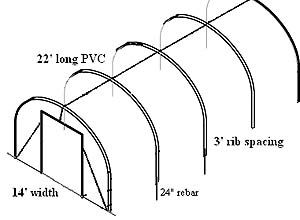| Class goers learn how to put together a green house. |
Field of dreams-how to profit from small fruit and vegetable production
Dan Drost earned his PhD from Cornell University in vegetable crops and plant physiology. He spoke at the summit on the subject of making a profit from a small fruit and vegetable production.
“Most people have a dream to utilize the small spaces around their property, and there is a huge demand for locally produced fruits and vegetables. We need to think of these types of activities and economic development because of the income they bring into rural areas. By earning extra income from growing fruits and vegetables, a family can also increase their retirement while utilizing their property,” said Drost.
Drost explained several projects he is involved with as a member of the Utah State University faculty as a horticulturist. He has been involved in building many passive solar, high tunnel greenhouses which are proving to extend the growing season and provide a way to begin that season earlier in the year. Late season crops provide more variety and freshness for the consumer.
“When we started this project in 2005 in Logan, we produced greens into December. Winter crops such as lettuce, spinach, and other hardy greens were being harvested later in the season. We would plant the seeds in November, harvest once in December, then cover the plants with horticulture blankets which enabled us to uncover the plants and harvest again in February,” said Drost.
He explained that summer crops such as tomatoes and cucumber were planted in late March and were being harvested in June. “Our squash harvest began this year May 15. The market for local produce is great and in these types of greenhouses, summer produce can be harvested very early in the season and bring top dollar for those products. There is money in early season produce,” added Drost. He said the first two harvests of tomatoes brought in enough money to pay for the construction of the greenhouse.
The plastic tunnels can be made any size the grower wishes. They can be designed to fit the area available, and two people can assemble one in four-five hours. There is no right or wrong way to design a high tunnel greenhouse.
For the foundation, a person merely drives four-foot rebar two feet into the ground, thus exposing two feet of rebar at the needed outside dimensions of the greenhouse. PVC pipe is then bent in a semi-circle from rebar to rebar forming the frame of the tunnel.
As for the walls, they are made of high grade, horticultural plastic sheeting. Because this plastic comes in 50 foot lengths, Drost recommends the length of the greenhouse be no longer than 50 feet to avoid having to make splices. A door can be framed and built into one end, while the other end will remain solid. The horticultural plastic will outlast contractor grade plastic sheeting by several years.
Baling twine is then tied to the rebar and tossed over the sheeting to the opposite side and tied to the rebar. This will make the support system stronger to withstand high winds. Another option is to build outside walls then set the tunnel on top of the walls for an even higher tunnel. “In Logan, our tunnels have survived 65 mile an hour winds, but things happen. Plan for the prevailing winds in your area,” said Drost.
In the summer months, the bottoms of the sidewalls can be rolled up for ventilation. USU installed drip irrigation systems in their project tunnels. They are also experimenting with other types of crops.
During the winter months, the snow load in some areas may create a problem. Usually with the rounded shape of the tunnel, the snow does not build up. But for added, protection, a center ridge line may want to be added for extra strength. This ridge line will keep the roof supported during the nighttime hours until the snow can be cleared in the day. The warmth from the greenhouse and the sun will usually remove the snow.
“In the inside of the tunnel, a person can use a peat moss, vermiculite, sand mixture for the growing medium or plain garden soil which is heavily composted. Use black plastic to cover the soil to prevent weeds, and plant in holes in the plastic,” concluded Drost.
He also reminded everyone not to forget the flowers. Many types of flowers can be grown in a tunnel type greenhouse.
Drost can be reached at dand@ext.usu.edu with questions.

